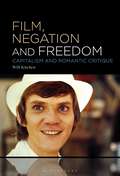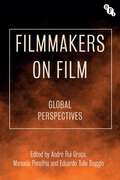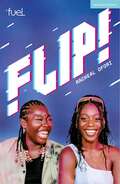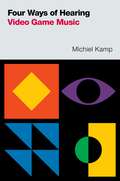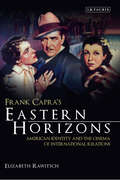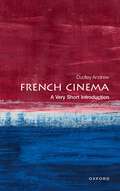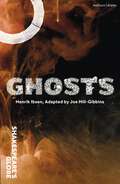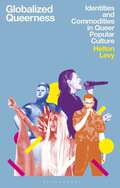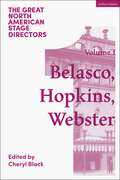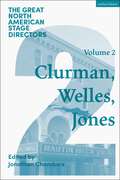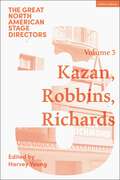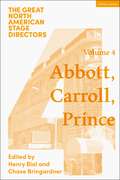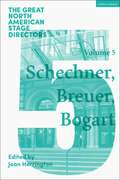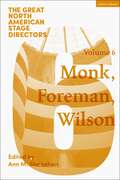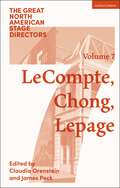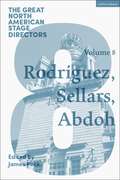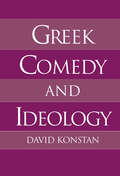- Table View
- List View
Film, Mobility and Urban Space: A Cinematic Geography of Liverpool
by Les RobertsDrawing on multi-disciplinary debates surrounding the cultural production of place, space and memory in the post-industrial city, Film, Mobility and Urban Space explores the role of moving images in representations and perceptions of everyday urban landscapes. The arguments put forward in the book are based on a case study of Liverpool in the north west of England and draw from a unique spatial database of over 1700 archive films of the city from 1897 to the present day. Theoretically wide-ranging in scope, Les Roberts’s study combines critical spatial analysis, archival research and qualitative methods to navigate a city’s cinematic geographies as mapped across a broad spectrum of film genres, including amateur film, travelogues, newsreels, promotional films, documentaries and features. As the second most filmed city in the UK – and formerly second city of Empire – Liverpool boasts a rich industrial, architectural and maritime heritage that has positioned the city – which was European Capital of Culture in 2008 – at the forefront of current debates on regeneration, visuality and cultural memory. The tension between the city as spectacle and the city as archive, and the contradictions that underpin the growing ‘cinematization’ of postmodern urban space are at the core of the arguments developed throughout the book. Examining the contention that, as spatial practices, the production and consumption of urban cinematic geographies are, in their different ways, tied to shifting cultures and geographies of mobility, Film, Mobility and Urban Space maps the critical interplay between material and immaterial spaces of the city and re-evaluates the significance – and ‘place’ – of location in contemporary film practice and urban cultural theory.
Film Nation: William Troy on the Cinema, 1933-1935
by James R RussoNotable writers on literature and culture who occasionally penned opinion pieces on the movies prior to World War II include Clifton Fadiman, Mark Van Doren, Lincoln Kirstein, Edmund Wilson, Louise Bogan, and Paul Goodman. All of these critics wrote seriously about things other than the movies. Indeed, the early decades of film criticism drew many moonlighters who tried their hand at it for a few years, then moved on to their preferred metier. And such was the case with William Troy (1903-1961). Troy, a distinguished literary critic whose posthumous Selected Essays won a National Book Award in 1968, was also a much-loved professor at Bennington College, the New School, and New York University. Troy was the film critic of The Nation from 1933 to 1935. To that post he brought an educated, almost professional tone, which he sometimes used for comic effect. He approached each piece of film criticism as an occasion for some larger essayistic rumination. Indeed, his feeling for the carpentry of the short review is superb, as the reader will detect in his pieces on such important films as Buñuel's L'age d'Or, Lang's M, Duvivier's Poil de Carotte, Eisenstein's Que Viva México!, Dreyer's The Passion of Joan of Arc, Cocteau's Blood of a Poet, Pudovkin's Mother, Flaherty's Man of Aran, Renoir's Madame Bovary, and Ford's The Informer. William Troy was thus one of Americas first full-time professional film critics, if not the best of the lot. He deserves some of the attention heretofore reserved for another important early critic, James Agee, who himself began writing movie reviews for The Nation in 1942. Published in conjunction with The Bookman: William Troy on Literature and Criticism, 1927-1950 (ISBN 978-1-78976-172-6), Film Nation is essential reading for cinephiles. Inclusion of a substantive index makes the work highly attractive for classroom adoption in the field of cinema studies.
Film, Negation and Freedom: Capitalism and Romantic Critique
by Will KitchenFilm, Negation and Freedom: Capitalism and Romantic Critique explores cinema in relation to the critical tradition in modern philosophy and its heritage in Romantic aesthetics. Synthesising a variety of discursive fields and traditions - including Early German Romanticism, Frankfurt School critical theory and the aesthetic philosophy of Jacques Rancière - Film, Negation and Freedom outlines a radical new approach to film by re-examining the work of Arthur Penn and Lindsay Anderson. A distinction between Light and Dark Romanticism is introduced as a means of interpreting cinema's relationship with capitalism, as well as dualistic concepts such as stillness and motion, passivity and activity, pain and pleasure. Film, Negation and Freedom revitalises our understanding of modern audio-visual media, as well as the aesthetic, philosophical and political conditions of Romantic subjectivity, artistic practice and spectatorship.
Filmmakers on Film: Global Perspectives
by André Rui Graça Eduardo Baggio Manuela PenafriaThis book bridges the gap between film theory and filmmakers' thoughts and poetics, and proposes a new way to address and elaborate film theory.It brings together primary sources by filmmakers themselves, drawing on their films, interviews, books, texts, and manifestos. Divided into three parts, the book covers the main aspects of this approach. Part one discusses the concepts of 'author' and 'filmmaker'. Part two evaluates the creative processes of a broad range of filmmakers, including Víctor Gaviria (Colombia), Kleber Mendonça Filho (Brazil), Jean-Luc Godard and Agnès Varda (France), Abbas Kiarostami (Iran) Pa. Ranjith (India), Andy Warhol (USA), Maya Deren (Ukraine-USA) and Nuri Bilge Ceylan (Turkey). The final part examines filmmakers' various techniques, particularly the use of multi-images, after-(dialectical)-images, and the use of sound as a sensorial and narrative tool. This curated selection of writings, with contributors from a range of countries including the USA, UK, India, China, Portugal, Brazil, Belgium and New Zealand, reflects the global perspective of this new approach. The volume also discusses the ways in which filmmakers influence each other, the spectator as seen by filmmakers, and ways to critically address a filmography that takes into account filmmakers other than the director.
The Films of Apichatpong Weerasethakul
Delving into Apichatpong Weerasethakul’s films, this book uncovers a plethora of conceptual paradigms. Apichatpong's films frequently utilize rural Thailand as a backdrop, showcasing daily life, interactions, rituals, and customs, all infused with a Southeast Asian essence. This utilization of local imagery provides a national quality to his works, allowing a global audience to explore both urban and rural aspects of Thai society, along with discourses on history, culture, politics, and practices. Beyond the surface, the films also address universal and intricate themes, transcending cultural boundaries. The book delves into a range of lesser-explored aspects regarding the films and filmmaking of Apichatpong, developing fresh perspectives on the representation of nonhumans, hybrid forms, transmedia plot, technique, production among others. With meticulous analyses of his key works this interdisciplinary study unveils the threads that bind Apichatpong’s creative practice, innovative techniques, and philosophical insights. An essential read for cinephiles, scholars, and seekers of cinematic depth, this book uncovers the vibrant tapestry of meaning within Apichatpong’s enigmatic film-worlds.
The Films of Michael Mann: From the Prison Wall to the Firewall
by Deryck SwanIs Michael Mann an auteur? Mann is a formidable filmmaking personality, no doubt, but the notion that today's celebrity cult of director immediately correlates with the mysterious sect of 'auteur' is questionable and deserves to be investigated. In doing so this book strives to emulate the methodology of the man himself, by ranging over not only the films he has made, from 1979’s The Jericho Mile to 2015's Blackhat, but also the scope of intellectual interests that they exemplify in an attempt to mine the commonalities, themes and traits that may suggest the presence of an auteur. Through his investigation of Mann's filmography and the personality that flows through it, author Deryck Swan provides the reader with accessible and new ways of thinking about his films to date, including, amongst myriad other things, references to painter Morris Louis, desert modernism, West Coast prison culture, Chicago Mayor Richard M. Daley, Strain Theory, journalist Mike Royko, Chicago's Auditorium building and a largely forgotten Charles Bronson film.
FLIP! (Modern Plays)
by Racheal OforiCall my narcissism whatever you want. And while you're at it; like, comment, subscribe, worship - fucking bow down.Meet Carleen and Crystal. The influencers with cultural commentary that will have you in stitches! Love them or hate them, there's no stopping their fast-growing online following. Offline, Carleen has her reservations about their cyber personas, but she idolises Crystal and would follow her anywhere… even to FLIP!, the new social media giant that has everyone hooked – and Carleen and Crystal are no exception; especially when it seems that their videos could make them famous.Superstardom, followers, fame, influence, money: it's all just one click away. FLIP! is the answer to everything they've ever dreamed of. But is it too good to be true?FLIP! is a powerful new satire from critically-acclaimed writer Racheal Ofori that probes what it means to live freely under the shadow of social media, encroaching on every aspect of our lives. How can we be our authentic selves in a world of algorithms intent on proving just how disposable we all are? Originally produced by Fuel in association with Alphabetti Theatre and co-commissioned by Fuel and Soho Theatre, as part of Soho Six. This edition was published to coincide with the world premiere and UK tour starting in October 2023.
The Fly (Devil's Advocates)
by Emma WestwoodIt's not often that a remake outshines its original but David Cronenberg's "reimagining" of The Fly (1986) is one of those rare exceptions. Equal parts horror, science fiction, and romance, The Fly takes the premise of its 1958 original—a man unintentionally fusing with a housefly during an experiment in teleportation—and reinterprets the plot as a gradual cellular metamorphosis between these two organisms.This book teases out the intricate DNA of The Fly and how it represents the personalities of many authors, including a distinguished history of Man-as-God tales stretching back to Mary Shelley's Frankenstein (1818). Drawing from interviews with cast, crew, film commentators, and other filmmakers, Emma Westwood interlaces the "making of" travails of The Fly with why it is one of the most important examples of master storytelling ever committed to screen.
Four Ways of Hearing Video Game Music (Oxford Music / Media)
by Michiel KampFour Ways of Hearing Video Game Music offers a novel account of the ways in which video games invite us to hear and listen to their music. By taking a phenomenological approach to characterize music in video games, author Michiel Kamp asks what it is we hear in the music when we play a game. Drawing on past phenomenological approaches to music as well as studies of music listening in a variety of disciplines such as aesthetics and ecological psychology, Kamp explains four main ways of hearing the same piece of music--through background, aesthetic, ludic, and semiotic hearing. As a background, music is not attended to at all, but can still be described in terms of moods, affordances, or equipment. Aesthetic hearing is a reflective attitude that invites hermeneutic interpretation; ludic hearing on the other hand invites "playing along" to the music, either through embodied movement, or in response to the music's cinematic or theatrical connotations. Finally, in semiotic hearing, Kamp argues that we hear music as transparent symbols or signals that provide information about the state of a game. The book investigates these four categories through detailed case studies of video games from a variety of eras and genres accompanied by gameplay recordings and images on a companion website.
Frank Capra's Eastern Horizons: American Identity and the Cinema of International Relations (Cinema and Society)
by Elizabeth RawitschFrank Capra has long had a reputation as being the quintessential American director - the man who perfectly captured the identity and core values of the United States with a string of classic films in the 1930s and '40s, including It Happened One Night, Mr. Smith Goes to Washington and It's a Wonderful Life. However, as Elizabeth Rawitsch argues, Capra's construction of national identity did not occur within an exclusively national context. She points out that many of his films are actually set in, or include sequences set in, China, Latin America, the Philippines and the South Seas. Featuring in-depth textual analysis supported by original archival research, Frank Capra's Eastern Horizons explains that Capra's view of what constituted 'America' changed over time, extending its boundaries to embrace countries often far from the United States.Complicating Edward Said's theory of Orientalism as a strict binary in which the West constructs the East as an inferior 'other', it demonstrates that East and West often intermingle in films such as The Bitter Tea of General Yen and in Capra's orientation documentaries for World War II American servicemen; Capra imagined a kind of global community, albeit one with heavy undertones of British and American imperialism. Investigating shifts in what Capra's America has meant over time, both to Capra and to those who have watched and studied his films, this innovative book offers a startlingly fresh perspective on one of the most iconic figures in American film history.
French Cinema: A Very Short Introduction (Very Short Introductions)
by Dudley AndrewIt is often claimed that the French invented cinema. Dominating the production and distribution of cinema until World War 1, when they were supplanted by Hollywood, the French cinema industry encompassed all genres, from popular entertainment to avant-garde practice. The French invented the "auteur" and the "ciné-club"; they incubated criticism from the 1920s to our own day that is unrivalled; and they boast more film journals, fan magazines, TV shows, and festivals devoted to film than anywhere else. This Very Short Introduction opens up French cinema through focusing on some of its most notable works, using the lens of the New Wave decade (1958-1968) that changed cinema worldwide. Exploring the entire French cinematic oeuvre, Dudley Andrew teases out distinguishing themes, tendencies, and lineages, to bring what is most crucial about French Cinema into alignment. He discusses how style has shaped the look of female stars and film form alike, analysing the "made up" aesthetic of many films, and the paradoxical penchant for French cinema to cruelly unmask surface beauty in quests for authenticity. Discussing how French cinema as a whole pits strong-willed characters against auteurs with high-minded ideas of film art, funded by French cinema's close rapport to literature, painting, and music, Dudley considers how the New Wave emerged from these struggles, becoming an emblem of ambition for cinema that persists today. He goes on to show how the values promulgated by the New Wave directors brought the three decades that preceded it into focus, and explores the deep resonance of those values today, fifty years later. ABOUT THE SERIES: The Very Short Introductions series from Oxford University Press contains hundreds of titles in almost every subject area. These pocket-sized books are the perfect way to get ahead in a new subject quickly. Our expert authors combine facts, analysis, perspective, new ideas, and enthusiasm to make interesting and challenging topics highly readable.
Frenzy (Devil's Advocates)
by Ian CooperFrenzy (1972) was Alfred Hitchcock's penultimate film, and arguably one of his most misunderstood and neglected. Whereas even Psycho (1960) did eventually become respectable – indeed, it's a good contender for the most admired of the Master's films - Frenzy still remains problematic for many. While Raymond De Foery makes his feelings clear in the title of his book, Alfred Hitchcock's Frenzy: The Last Masterpiece, Hitchcock's controversial biographer Donald Spoto calls the film "repulsive" and "a closed and coldly negative vision of human possibility". Frenzy is perhaps Hitchcock's most nakedly autobiographical film, representing both a comeback and farewell to the city of his birth. But it started out as a very different kind of project. This Devil's Advocate discusses the evolution of the film, its production, reception, and place in Hitchcock's oeuvre, as well as its status as a key film of "sleazy Seventies" British cinema.
The Gentleman Dancing-Master: Mr Isaac and the English Royal Court from Charles II to Queen Anne (Clemson University Press: Studies in British Musical Cultures)
by Jennifer ThorpThe Gentleman Dancing-Master: Mr Isaac and the English Royal Court from Charles II to Queen Anne is a study of the life of the most significant dancing-master at the late-Stuart court in London. It discusses his use of dance music and brings together, for the first time, reprints of the notations of all his twenty-three surviving dances created for performance at court in the presence of the monarch, including several created to celebrate the birthdays of Queen Anne or named after important courtiers or political events. This study highlights the significance of dance as a central part of court culture, and also the wider context of the London book trade within which Isaac’s notators turned his dances into a publishable form ultimately taken over by John Walsh’s music publishing firm. Using extensive archival and printed sources from his day, the book follows Isaac’s career as a dancer, teacher, and choreographer of sophisticated duets in the fashionable French style, some of which were also performed in the theatre. Isaac, however, was no slavish follower of French fashion, and by careful consideration of the extant dances from the point of view of a dancer, this study also seeks to throw light on Isaac’s often individualistic approach to choreography.
Ghosts (Modern Plays)
by Henrik IbsenThere are ghosts everywhere. There are ghosts here right now.Plagued by the ugly truth of her late husband's legacy, Helene vows to erase the past and start again.Ignorant to the reality of his father's character, Osvald, her son, returns home to face an uncertain future. But when the ember of an illicit romance stands to ruin Helene's plans to play happy family, she is forced to make a decision that threatens to engulf what's left of her – and her son's – life completely.Experience the work of Henrik Ibsen, one of the most influential dramatists of all time, in a scandalous and searing exploration of family secrets and forbidden desire. Nearly 150 years after causing a furore when it premiered with its depiction of incest, infection and euthanasia, adaptor and director Joe Hill-Gibbins (The Marriage of Figaro, ENO; The Tragedy of King Richard The Second, Almeida), in his Globe debut, brings a new version of Ghosts, the first modern tragedy, to the Sam Wanamaker Playhouse.Ghosts was part of the Sam Wanamaker Playhouse 10th Anniversary Season. This edition was published to coincide with the world premiere at The Globe's Sam Wanamaker Playhouse in November 2023.
A Girl Walks Home Alone at Night (Devil's Advocates)
by Farshid KazemiThere is something weird and eerie going on in the oneiric Iranian ghost-town Bad City. A mysterious female vampire, clad in a long-black veil, imbued with occult and erotic power, has newly arrived in town and is summarily dispensing with its unsavory characters. Through a chance encounter in a night of luminal darkness, an eternally dark romance begins – baptized in love’s blood. Shot in dazzling anamorphic black and white cinematography and accompanied with an intoxicating and mesmeric soundtrack, Ana Lily Amirpour’s debut feature film A Girl Walks Home Alone At Night (2014), was an instant popular and critical success. Dubbed ‘the first Iranian vampire western’ the genre-bending film is a pastiche of genres such as vampire cinema, gothic and horror films, spaghetti westerns, graphic novels, and Iranian cinema; yet the film stands as a new vampire fairy-tale with a unique style all its own. The first full-length study dedicated to the film since its release, this book in the Devil’s Advocate series provides a unique approach to the film situated within three theoretical coordinates: the vampire genre, psychoanalytic (film) theory and German Idealism.
Globalized Queerness: Identities and Commodities in Queer Popular Culture (Library of Gender and Popular Culture)
by Helton LevyHas a global queer popular culture emerged at the expense of local queer artists? In this book, Helton Levy argues that global queer culture is indebted to specific, local references that artists carry from their early experiences in life, which then become homogenized by contemporary media markets. The assumption that queer publics live and consume only through a global set of references, including gay parades and rainbow flags, for example, erases many personal complexities.Levy revisits media characters that have caught the attention of the broader public – such as Calamity Jane (1953), the Daffyd Thomas character from the BBC comedy Little Britain (2003-2007), Brazilian drag queen Pabblo Vittar, French singer Christine and the Queens, and the Italian-Egyptian rapper Mahmood – and argues that they have gradually blended in the public's perception. This has often obscured the individual struggles faced by these characters, such as immigration, homophobia, poverty and societal exclusion. Levy also questions what happens when global media flows take queer culture to regions wherein the notion of LGBTQ+ rights are not entirely acceptable. Utilizing insights from media reports published across the world's ten biggest media markets, Levy argues that there are a series of conditions which artists and cultural actors negotiate once they achieve any kind of success in mainstream media, while local queer references remain unseen in the wider media world. For that reason, he argues for stronger incentives for communities to accept and acknowledge the work of queer people before and after commoditization.
Great North American Stage Directors Volume 1: David Belasco, Arthur Hopkins, Margaret Webster (Great Stage Directors)
by Professor James PeckThis volume assesses the contributions of David Belasco, Arthur Hopkins, and Margaret Webster, whose careers shaped the artistic and specialist identity of the Broadway director. Their work spans almost a century and captures the rapidly changing social and cultural landscape of 20th-century America. While their aesthetic styles differed greatly, they were united in their mastery of theatre craft and their impact on theatrical collaboration. The essays in this volume explore how these directors established and exploited Broadway as the epicentre of theatre in the United States, blended the role of producer and director, and managed the tensions between commercial success and artistic ambition.The Great North American Stage Directors series provides an authoritative account of the art of directing in North America by examining the work of twenty-four major practitioners from the late 19th century to the present. Each of the eight volumes examines three directors and offers an overview of their practices, theoretical ideas, and contributions to modern theatre. The studies chart the life and work of each director, placing his or her achievement in the context of other important theatre practitioners and broader social history. Written by a team of leading experts, the series presents the genealogy of directing in North America while simultaneously chronicling crucial trends and championing contemporary interpretation.
Great North American Stage Directors Volume 2: Harold Clurman, Orson Welles, Margo Jones (Great Stage Directors)
by Professor James PeckThis volume assesses the accomplishments of three mid-20th century, North American stage directors: Harold Clurman, Orson Welles, and Margo Jones. Though their theatre-making endeavours were distinct, each produced work that challenged preconceived notions of theatre-making, all while working within the structure of a company. As directors drawn to the potential rewards of collaboration, all also were keenly adept at understanding how the relationship with a company of collaborators is often marked by struggle and crisis. The essays in this volume explore how these accomplished directors not only created bold work, but also drew on the complex energies of the theatre companies with which they worked to reimagine the shape and scope of theatre directing.The Great North American Stage Directors series provides an authoritative account of the art of directing in North America by examining the work of twenty-four major practitioners from the late 19th century to the present. Each of the eight volumes examines three directors and offers an overview of their practices, theoretical ideas, and contributions to modern theatre. The studies chart the life and work of each major North American theatre director, placing his or her achievement in the context of other important theatre practitioners and broader social history. Written by a team of leading experts, the series presents the genealogy of directing in North America while simultaneously chronicling crucial trends and championing contemporary interpretation.
Great North American Stage Directors Volume 3: Elia Kazan, Jerome Robbins, Lloyd Richards (Great Stage Directors)
by Professor James PeckThis volume chronicles the lives and artistry of Elia Kazan, Jerome Robbins, and Lloyd Richards. Their commitment to staging new works, which often focused on the experiences of immigrant and working-class families, significantly expanded the scope and possibilities of American theatre across the 20th century. It illuminates too their collaborations with a range of innovative theatre artists, including Lee Strasberg, Clifford Odets, Marlon Brando, Arthur Miller, Tennessee Williams, Lorraine Hansberry, Leonard Bernstein, Stephen Sondheim, and August Wilson.The Great North American Stage Directors series provides an authoritative account of the art of directing in North America by examining the work oftwenty-four major practitioners from the late 19th century to the present. Each of the eight volumes examines three directors and offers an overview of their practices, theoretical ideas, and contributions to modern theatre. The studies chart the life and work of each director, placing his or her achievement in the context of other important theatre practitioners and broader social history. Written by a team of leading experts, the series presents the genealogy of directing in North America while simultaneously chronicling crucial trends and championing contemporary interpretation.
Great North American Stage Directors Volume 4: George Abbott, Vinnette Carroll, Harold Prince (Great Stage Directors)
by Professor James PeckGeorge Abbott, Vinnette Carroll, and Harold (Hal) Prince were trailblazing figures who helped shape and define the Broadway musical over the course of the 20th century. Their careers expanded the boundaries of the genre, highlighting the critical role of the director in the creation of a new musical. As theatre history, the essays in this volume help to complicate and deepen the reader's understanding of the musical genre of Broadway and of the enduring legacies of these three pioneers. As lessons in theatrical direction, they illustrate the particular issues involved in directing musicals, as well as the stakes of working commercially at the highest levels of the industry.The Great North American Stage Directors series provides an authoritative account of the art of directing in North America by examining the work of twenty-four major practitioners from the late 19th century to the present. Each of the eight volumes examines three directors and offers an overview of their practices, theoretical ideas, and contributions to modern theatre. The studies chart the life and work of each director, placing his or herachievement in the context of other important theatre practitioners and broader social history. Written by a team of leading experts, the series presents the genealogy of directing in North America while simultaneouslychronicling crucial trends and championing contemporary interpretation.
Great North American Stage Directors Volume 5: Richard Schechner, Lee Breuer, Anne Bogart (Great Stage Directors)
by Professor James PeckRichard Schechner, Lee Breuer, and Anne Bogart share a spirit of profound adventure and that adventure is the redefinition of theatre itself. They are rare hybrids; the confluence of their theatrical roles as directors, scholars, theorists and teachers has placed them among the most influential thinker/practitioners of their generation. This book reveals the ways in which their consistent inquiry enabled them to re-examine, re-frame, and re-invent their own practice. The essays in this volume explore the ways in which Schechner, Breuer and Bogart have established powerful legacies of consistently innovative theatre most often created in the company of an ensemble of collaborative artists. Their influence is undeniable in the reformulation of theatre practices from the 1970s onward. The Great North American Stage Directors series provides an authoritative account of the art of directing in North America by examining the work of twenty-four major practitioners from the late 19th century to the present. Each of the eight volumes examines three directors and offers an overview of their practices, theoretical ideas, and contributions to modern theatre. The studies chart the life and work of each director, placing his or her achievement in the context of other important theatre practitioners and broader social history. Written by a team of leading experts, the series presents the genealogy of directing in North America while simultaneously chronicling crucial trends and championing contemporary interpretation.
Great North American Stage Directors Volume 6: Meredith Monk, Richard Foreman, Robert Wilson (Great Stage Directors)
by Professor James PeckThis volume assesses the work of Meredith Monk, Richard Foreman, and Robert Wilson, three artists who have revolutionized the craft of directing and the art of theatre in both related and unique ways. Though their early artistic backgrounds differ, ranging from architecture, music and dance to writing, they are similar in that none of them began their career as a director per se or received formal training as such. They each assumed the director's role based on the demands of their complex artistic visions, which combine art forms, but resist synthesis, finding expression in the differences and tensions between the forms. The essays in this volume explore how these auteur directors combine text, movement, film, sound and music, installation and visual arts to achieve their visions, employing multi-perceptual modes to evoke full and rich theatrical experiences. The Great North American Stage Directors series provides an authoritative account of the art of directing in North America by examining the work of twenty-four major practitioners from the late 19th century to the present. Each of the eight volumes examines three directors and offers an overview of their practices, theoretical ideas, and contributions to modern theatre. The studies chart the life and work of each director, placing his or her achievement in the context of other important theatre practitioners and broader social history. Written by a team of leading experts, the series presents the genealogy of directing in North America while simultaneously chronicling crucial trends and championing contemporary interpretation.
Great North American Stage Directors Volume 7: Elizabeth LeCompte, Ping Chong, Robert Lepage (Great Stage Directors)
by Professor James PeckThis volume focuses on three artists who embrace media and technology as essential elements of their theatrical expression: Elizabeth LeCompte, Ping Chong, and Robert Lepage. Diverse in their aesthetic interests, they nevertheless share an approach to directing that includes technological media on stage as central to a rigorously crafted production concept. Technological elements live alongside and negotiate with the theatre's human players, disclosing, shaping, and even intruding on the dramas they enact. The essays in this volume explore how all three directors have provided decisive responses to a question that has dogged the theatre for at least the last century: what relationship can theatre, an art form grounded in live, ephemeral, expression, have to technology?The Great North American Stage Directors series provides an authoritative account of the art of directing in North America by examining the work of twenty-four major practitioners from the late 19th century to the present. Each of the eight volumes examines three directors and offers an overview of their practices, theoretical ideas, and contributions to modern theatre. The studies chart the life and work of each director, placing his or her achievement in the context of other important theatre practitioners and broader social history. Written by a team of leading experts, the series presents the genealogy of directing in North America while simultaneously chronicling crucial trends and championing contemporary interpretation.
Great North American Stage Directors Volume 8: Jesusa Rodriguez, Peter Sellars, Reza Abdoh (Great Stage Directors)
by Professor James PeckThe three directors gathered in this volume all approach theatre-making in part as an act of citizenship. Jesusa Rodríguez, Peter Sellars, and Reza Abdoh differ markedly in many important respects, but they all come to the theatre as an intervention in the public sphere. Rodríguez, Sellars, and Abdoh blend a spirit of social critique with acts of democratic community building. These essays examine how theatre, for them, is not a sphere of aesthetic experience insulated from the divisions, antagonisms, and alliances of a conflicted society. It is a way to forge fleeting but consequential communities that might reverberate through that society and affect its future development.The Great North American Stage Directors series provides an authoritative account of the art of directing in North America by examining the work of twenty-four major practitioners from the late 19th century to the present. Each of the eight volumes examines three directors and offers an overview of their practices, theoretical ideas, and contributions to modern theatre. The studies chart the life and work of each director, placing his or her achievement in the context of other important theatre practitioners and broader social history. Written by a team of leading experts, the series presents the genealogy of directing in North America while simultaneously chronicling crucial trends and championing contemporary interpretation.

